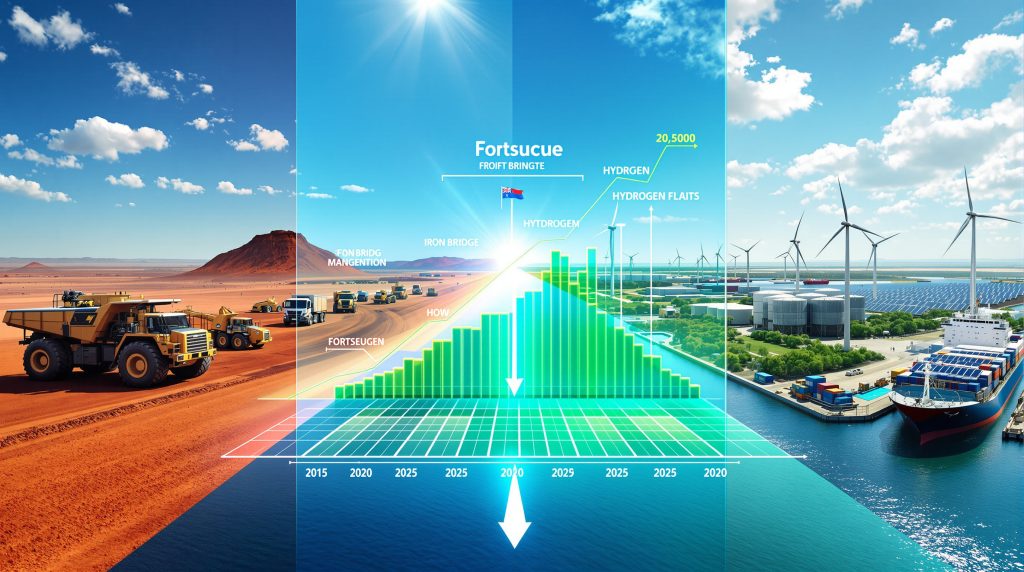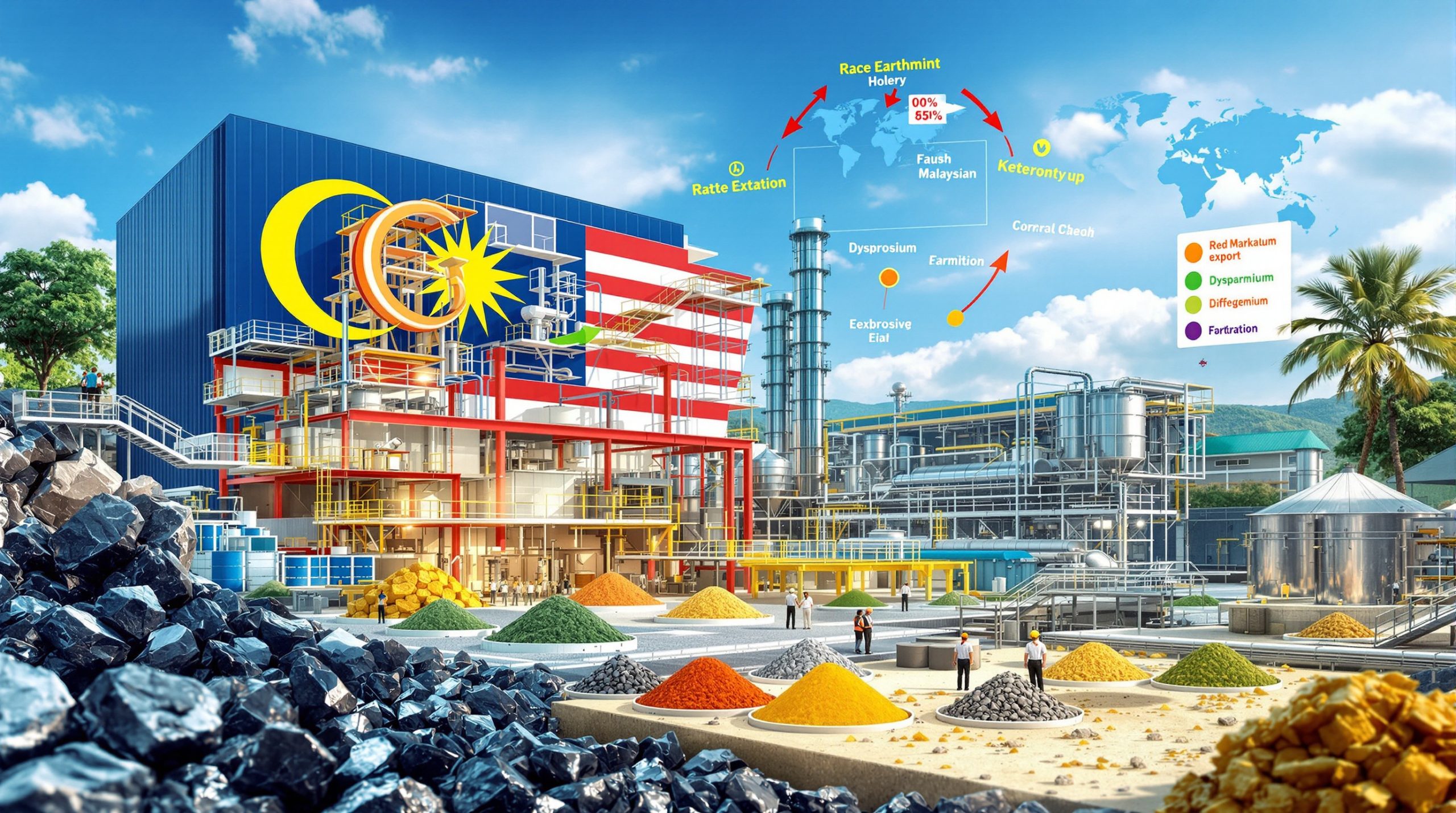Fortescue Earnings Forecast to 2030: What Investors Need to Know
Fortescue Metals Group (ASX: FMG) stands at a pivotal moment in its financial journey, with projections suggesting a period of challenges followed by recovery towards the end of the decade. For investors seeking clarity on what lies ahead for this iron ore giant, understanding the earnings forecast for Fortescue shares becomes crucial for making informed decisions.
What is the Current Financial Position of Fortescue?
Fortescue Metals Group has recently faced significant headwinds in its financial performance. The FY25 results revealed a substantial decline in profitability, with an EBITDA of US$7.9 billion and net profit after tax (NPAT) of US$3.4 billion. This represents a 41% decrease from the previous year's performance, indicating the cyclical nature of the mining industry.
Despite this profit compression, Fortescue maintains a robust balance sheet structure. The company holds approximately US$4.3 billion in cash reserves while reducing its net debt position to US$1.1 billion. This financial resilience has allowed the company to maintain its shareholder returns policy, distributing a total dividend of A$1.10 per share in FY25.
Financial analysts note that while the profit figures fell slightly below expectations (with NPAT being a "tad soft" compared to analyst projections of US$3.5 billion), the company's operational performance remained largely in line with forecasts. This suggests that the profit decline stems primarily from external market factors rather than operational inefficiencies.
How Will Iron Ore Prices Impact Fortescue's Future Earnings?
Short-Term Price Projections (FY26-27)
The iron ore market faces potential downward pressure in the near term. Current iron ore trends suggest moderate price declines, with iron ore expected to trade around US$90 per tonne in 2026 before potentially decreasing further to approximately US$88 per tonne in 2027.
These projections reflect anticipated market dynamics, particularly the commencement of operations at the Simandou project in Guinea, West Africa. This massive iron ore development represents one of the world's largest untapped high-grade iron ore reserves and will likely introduce significant additional supply to global markets.
Industry observers note that current iron ore fundamentals appear "balanced," with projects like Mineral Resources' Onslow operation running at expected capacity. However, the Simandou development will potentially create a structural shift toward oversupply as production ramps up, creating what market analysts describe as a "key overhang" for iron ore prices in the coming years.
While a fatal incident at Simandou Sifer has caused some temporary delays, analysts expect only a short-term impact before development continues. This suggests the supply pressure will materialize, albeit with slight timing adjustments.
Long-Term Price Outlook (FY28-30)
Beyond 2027, the iron ore market may potentially reach a new equilibrium as supply growth moderates and global demand patterns evolve. While specific iron ore forecast insights remain subject to considerable uncertainty, the general expectation points toward potential stabilization that could support Fortescue's projected earnings improvement from FY28 onward.
Market experts suggest several factors could contribute to this stabilization:
- Potential slowdown in new supply additions after Simandou reaches steady-state production
- Gradual recovery in global steel demand outside China as infrastructure development accelerates in developing regions
- Potential supply discipline from major producers if prices remain under pressure
- Growing premium for higher-grade iron ore products as environmental regulations tighten globally
What is Fortescue's Projected Earnings Trajectory to 2030?
FY26: Continued Profit Compression
The immediate outlook for Fortescue suggests further earnings pressure. For FY26, financial analysts project a net profit decline of approximately US$400 million to around US$3 billion. This represents a 12% decrease from FY25 levels, reflecting several key factors:
- Expected lower average realized iron ore prices (approximately US$90 per tonne)
- Initial market impact from Simandou project commencement
- Ongoing capital investments in decarbonization initiatives affecting short-term returns
- Potential margin compression as operating costs face inflationary pressures
Revenue is forecast to decrease by roughly 5% from FY25 levels, while earnings per share could experience a reduction of approximately 14%, reflecting the challenging market environment.
FY27: Reaching the Earnings Trough
FY27 potentially represents the bottom of Fortescue's earnings cycle within this forecast period. Net profit could decrease by another US$300 million to approximately US$2.7 billion as iron ore prices face continued pressure from increased global supply, potentially reaching around US$88 per tonne.
This period likely marks the most challenging point in Fortescue's medium-term financial trajectory, influenced by:
- Further iron ore price pressure as Simandou production continues ramping up
- Continued capital expenditure requirements for growth and sustainability projects
- Transitional costs associated with decarbonization efforts across operations
- Potential market share adjustments as buyers negotiate in an oversupplied environment
FY28: Beginning of Recovery
The 2028 financial year represents a projected inflection point for Fortescue's earnings trajectory. Financial models suggest net profit could increase by more than US$400 million to approximately US$3.1 billion, representing a 15% improvement from FY27.
This recovery appears driven by multiple factors:
- Iron Bridge magnetite project reaching nameplate capacity, contributing higher-margin products
- Potential stabilization in iron ore markets as supply growth moderates
- Operational efficiency improvements across the production chain
- Initial returns from green energy investments beginning to materialize
- Cost benefits from completed electrification and decarbonisation initiatives reducing operational expenses
FY29-30: Strengthening Performance
The final years of the decade demonstrate continued improvement in Fortescue's projected financial performance:
- FY29: Net profit forecast to reach US$3.6 billion, representing a US$500 million increase from FY28
- FY30: Further growth to approximately US$3.8 billion, marking the strongest projected earnings in the second half of the decade
This strengthening performance suggests Fortescue's operational improvements and diversification efforts may begin yielding substantial benefits during this period, potentially offsetting any lingering pressure in iron ore markets through improved operational efficiency and product mix optimization.
How is Fortescue's Green Energy Strategy Affecting Forecasts?
Current Decarbonization Initiatives
Fortescue has positioned itself as an industry leader in sustainability through significant commitments to decarbonization and green energy development. Market observers have noted the company's "increasing focus on delivery of decarbonisation" as a strategically positive direction for long-term competitiveness.
The company's green initiatives span multiple areas:
- Renewable energy generation capacity for mining operations
- Green hydrogen and ammonia production capabilities development
- Electrification of mining fleet and equipment to reduce emissions
- Carbon capture and utilization technologies exploration
- Supply chain decarbonization through shipping and logistics improvements
These investments represent substantial capital commitments in the near term but are increasingly viewed as strategic necessities for maintaining social license to operate and ensuring long-term market access.
Impact on Financial Projections
Financial analysts have expressed measured optimism regarding Fortescue's energy transition strategies while acknowledging potential timeline adjustments. The earnings forecasts incorporate several key considerations:
- Near-term capital expenditure creating pressure on free cash flow and profitability
- Gradual integration of green technologies into core operations improving efficiency
- Potential for improved operational costs in later years as renewable energy reduces exposure to fossil fuel price volatility
- Strategic positioning for future market requirements and potential premium pricing for low-carbon products
Industry observers note that some hydrogen and ammonia projects may face delays until these markets develop more fully, suggesting a pragmatic approach to green energy investment that balances innovation with financial discipline.
The financial impact of these initiatives appears most evident in the FY26-27 period, with potential benefits beginning to materialize from FY28 onward as technologies mature and market conditions evolve to reward low-carbon production.
What Key Projects Will Drive Fortescue's Future Performance?
Iron Bridge Magnetite Project
The Iron Bridge project represents a significant diversification of Fortescue's production capabilities and product mix. This development will be crucial between now and FY28, with expectations for reaching nameplate capacity during that financial year.
Key aspects of the Iron Bridge project include:
- Production of premium high-grade magnetite concentrate (67% Fe)
- Annual production target of 22 million tonnes when fully operational
- Potential for premium pricing relative to standard iron ore products due to higher grade
- Improved environmental performance through reduced emissions per tonne of steel produced
- Enhanced market positioning in a potentially carbon-constrained steel industry
The successful ramp-up of Iron Bridge appears integral to Fortescue's projected earnings recovery from FY28 onward, providing both volume growth and product quality improvements that could partially insulate the company from broader iron ore price pressures.
Green Energy Ventures
While specific green energy projects aren't individually quantified in earnings forecasts, their overall trajectory suggests these initiatives will contribute more meaningfully to Fortescue's financial performance in the latter part of the decade.
Industry experts note that hydrogen and ammonia markets remain in early development stages, potentially necessitating a measured approach to capital deployment. This indicates a pragmatic strategy that balances innovation with financial prudence, potentially staging investments to align with market readiness.
The timing of returns from these investments remains subject to considerable uncertainty, but the projected earnings improvement in FY29-30 suggests these initiatives may begin delivering measurable financial benefits toward the end of the decade.
What Are the Key Risks to Fortescue's Earnings Forecast?
Market-Related Risks
-
Iron Ore Price Volatility: The forecasts assume relatively moderate declines in iron ore prices, but more significant movements could substantially alter earnings projections. Every US$5/tonne change in the realized iron ore price can impact annual EBITDA by hundreds of millions of dollars.
-
Chinese Demand Fluctuations: China remains the primary market for iron ore, representing over 70% of global seaborne demand. Changes in Chinese economic growth, construction activity, steel production policies, or environmental regulations could significantly affect iron ore demand insights and pricing.
-
Simandou Development Timeline: Any acceleration or delay in the Simandou project could alter supply-demand dynamics differently than anticipated. The project's massive scale means even modest timeline adjustments could have material impacts on market balance.
-
Global Economic Conditions: Broader macroeconomic factors including interest rates, inflation, currency movements, and potential recessionary periods could influence both demand and pricing beyond current projections.
Operational Risks
-
Iron Bridge Ramp-Up Challenges: Magnetite processing involves considerably more complex operations than traditional hematite mining. Delays or technical issues in reaching nameplate capacity at Iron Bridge would impact the projected earnings recovery from FY28 onward.
-
Green Technology Implementation: The pace and cost of implementing decarbonization technologies could differ from expectations. These cutting-edge technologies carry inherent execution risks that could affect both capital expenditure requirements and operational efficiency gains.
-
Production Costs: Changes in energy prices, labor costs, or regulatory requirements could impact production costs beyond current projections. Australia's mining regions have experienced significant cost inflation in recent years, creating potential margin pressure.
-
Weather and Natural Events: Extreme weather events, particularly in the cyclone-prone Pilbara region, could disrupt production or damage infrastructure beyond normal contingency planning.
How Do Dividends Factor Into Fortescue's Financial Outlook?
Despite the projected earnings decline in FY26-27, Fortescue's strong balance sheet suggests continued capacity for dividend payments throughout the forecast period. The company distributed total dividends of A$1.10 per share in FY25, demonstrating its commitment to shareholder returns even amid challenging market conditions.
Fortescue's dividend approach reflects several key considerations:
- Maintenance of substantial cash reserves (US$4.3 billion) providing flexibility for shareholder returns
- Historical commitment to industry-leading payout ratios when financial conditions permit
- Balance between capital returns and investment in growth initiatives
- Strategic importance of yield for maintaining investor interest during cyclical downturns
While specific dividend forecasts through 2030 remain subject to actual financial performance, the projected earnings recovery from FY28 onward would likely support stable or potentially increasing dividend payments in the latter part of the decade, subject to capital allocation decisions and market conditions.
For income-focused investors, this suggests that while dividend yields may experience pressure during FY26-27, the longer-term outlook appears more favorable as earnings potentially recover and strengthen.
What Is the Consensus View on Fortescue Shares?
Current analyst assessments indicate a mixed outlook for Fortescue shares, reflecting differing perspectives on several key factors:
- The severity and duration of iron ore price pressures
- The pace of earnings recovery from FY28 onward
- The long-term value of green energy investments
- The impact of operational improvements and cost management
This diversity of perspectives highlights the complexity of valuing a company with Fortescue's exposure to commodity price cycles, significant capital projects, and strategic transformation initiatives.
Analyst recommendations span the spectrum from cautious to optimistic, reflecting various assumptions about:
- Long-term iron ore price forecasts
- Success and timing of the Iron Bridge project
- Valuation of the green energy business segment
- Capital allocation between growth initiatives and shareholder returns
- Broader market sentiment toward resource stocks in a transitioning global economy
According to Fortescue's investor information, the company remains focused on delivering both operational excellence and strategic growth initiatives despite market challenges. Similarly, analyst estimates from AlphaSpread suggest varied opinions on Fortescue's future performance, reflecting the complex interplay of factors affecting the company's outlook.
Conclusion: What's the Long-Term Outlook for Fortescue?
The earnings forecast for Fortescue shares through 2030 presents a narrative of near-term challenges followed by gradual recovery and strengthening performance. While profits are expected to decline through FY27, the subsequent years show improving financial results, with FY30 projected to deliver the strongest performance of the latter half of the decade.
This trajectory reflects both cyclical factors in iron ore markets and structural changes within Fortescue's business model, particularly through:
- Product diversification via the Iron Bridge magnetite project
- Integration of green energy technologies across operations
- Strategic positioning for a lower-carbon future in steel production
- Operational efficiency improvements driving margin enhancement
Fortescue's strong balance sheet provides resilience during the projected downturn, with substantial cash reserves and manageable debt levels creating financial flexibility. This strength allows the company to maintain its strategic initiatives even through challenging market conditions, potentially emerging stronger as the decade progresses.
For investors, this outlook suggests a period of patience may be required, with the most significant earnings improvements not expected until FY28 and beyond. However, the projected recovery path indicates potential for renewed financial strength as the decade progresses, potentially rewarding those with longer investment horizons.
The coming years will test Fortescue's ability to navigate both industry-specific challenges and broader economic transitions. Success will likely depend on disciplined execution of core business improvements while strategically advancing decarbonization initiatives to position for future market requirements.
Disclaimer
This analysis contains forward-looking statements based on current market conditions and projections. Actual results may differ materially from these forecasts due to numerous factors including commodity price movements, regulatory changes, operational developments, and broader economic conditions. Investors should conduct their own research and consider their individual financial circumstances before making investment decisions.
Looking to Identify the Next Major Mineral Discovery?
Discover how significant mineral finds can lead to exceptional market returns by exploring Discovery Alert's dedicated discoveries page, powered by their proprietary Discovery IQ model. Begin your 30-day free trial today at Discovery Alert to position yourself ahead of the market when the next major ASX discovery is announced.




